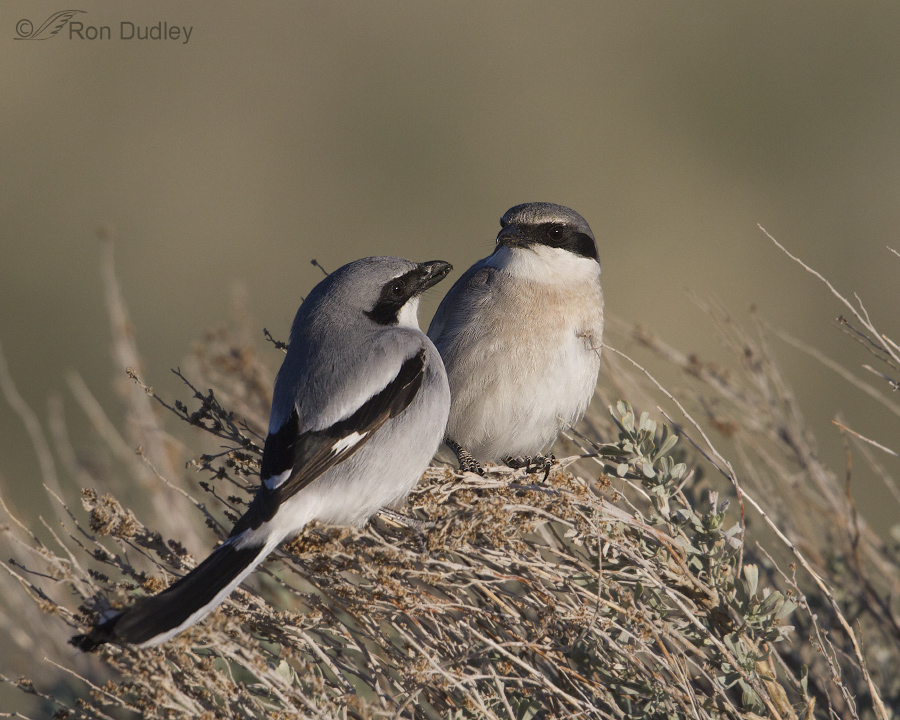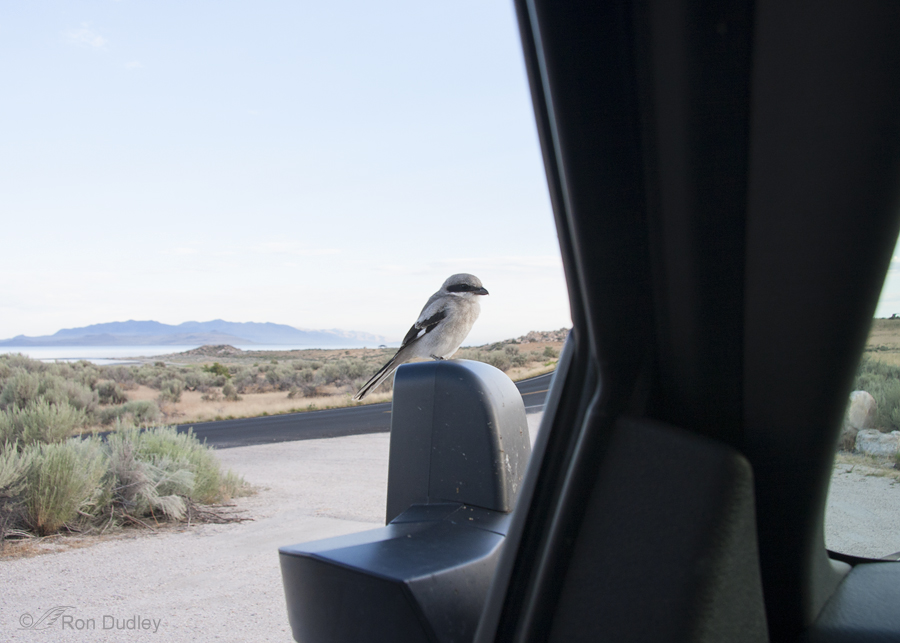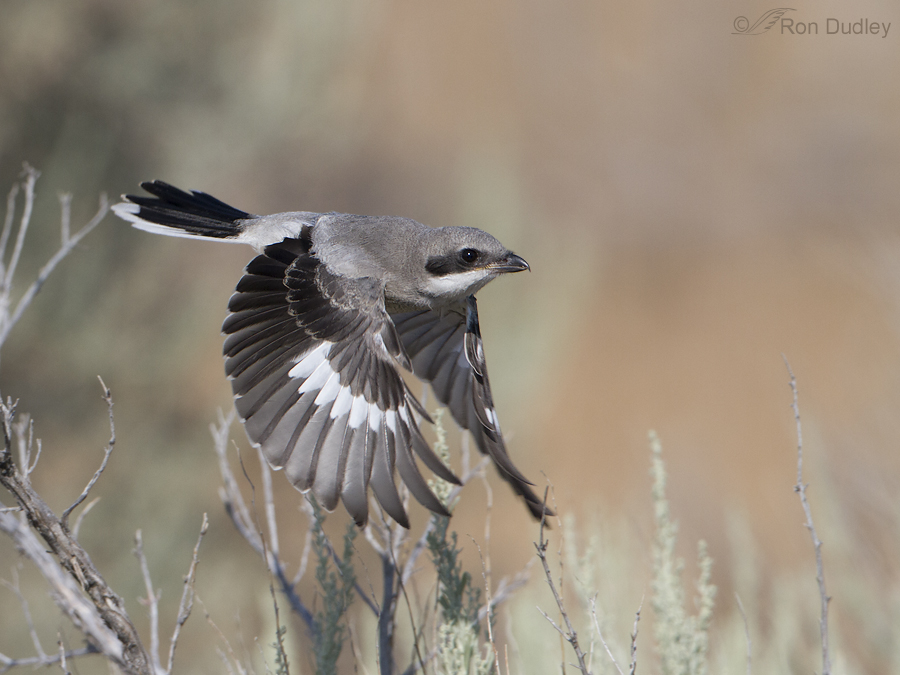Tag: loggerhead shrike
Birds “Wearing To Dark” – Some Visual Evidence As To Why
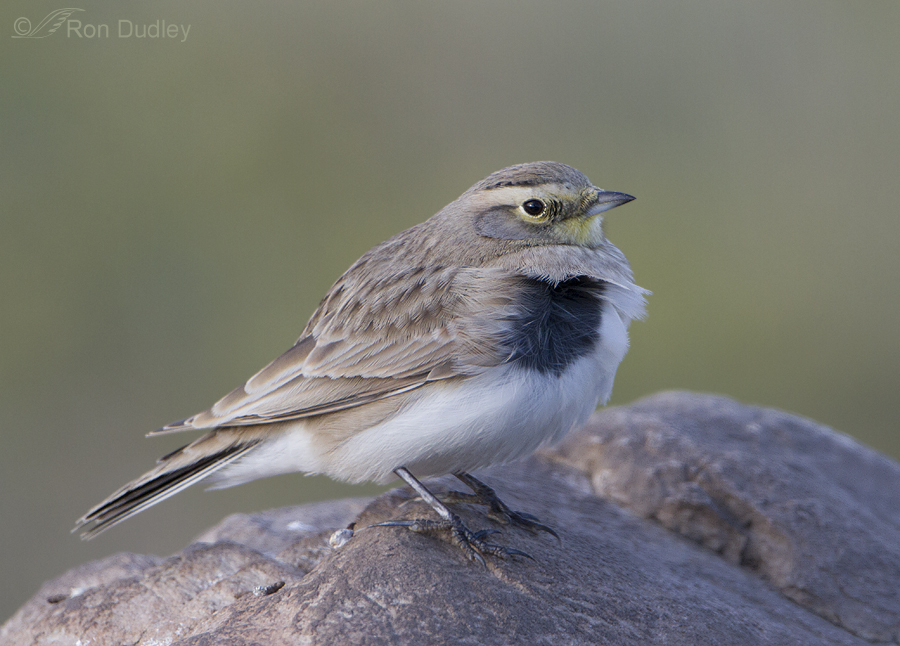
This past summer I posted these first two Loggerhead Shrike images as evidence that the ventral colors of the species change from white to almost black as the summer wears on and asked my readers why this occurs. Several responded with a logical explanation.
Three days ago I photographed a Horned Lark that may demonstrate that those readers were right.
Loggerhead Shrikes – A Color Change I Don’t Understand
I’m confused about a color change I’m seeing in Loggerhead Shrikes. 1600, f/7.1, ISO 640, 500 f/4, 1.4 tc, natural light, image taken 4/26/13 on Antelope Island For most of the year the adults I see have a white or pale ventral surface (belly, breast and sides) which is exactly as described in the field guides and other resources I have access to. 2500, f/6.3, ISO 640, 500 f/4, natural light, image taken 7/3/13 on Antelope Island But beginning in about early July there’s a fairly dramatic change that is not addressed in my field guides. That white plumage turns significantly darker and an almost black area on the upper breast appears. This is about the time they’re fledging chicks around here and when I first noticed this several years ago I wondered if the birds were simply becoming “dirty” as they scurried around trying to feed and care for those very demanding youngsters. But now I’m pretty sure that’s not the case. All of the adult Loggerhead Shrikes I see go through this change to some degree or another. 3200, f/5.6, ISO 640, 500 f/4, 1.4 tc, natural light, image taken 7/14/13 on Antelope Island Here’s another (pretty silly looking) example. This is also the time of year when these birds are molting so I wondered if I was somehow seeing black skin (some birds do have black skin) through very skimpy plumage that time of year and I was somehow mistaking it for black feathers. But as you can see in this preening, molting adult, their skin…
Enveloped By Shrikes!
Fledgling Loggerhead Shrike Begging For Food
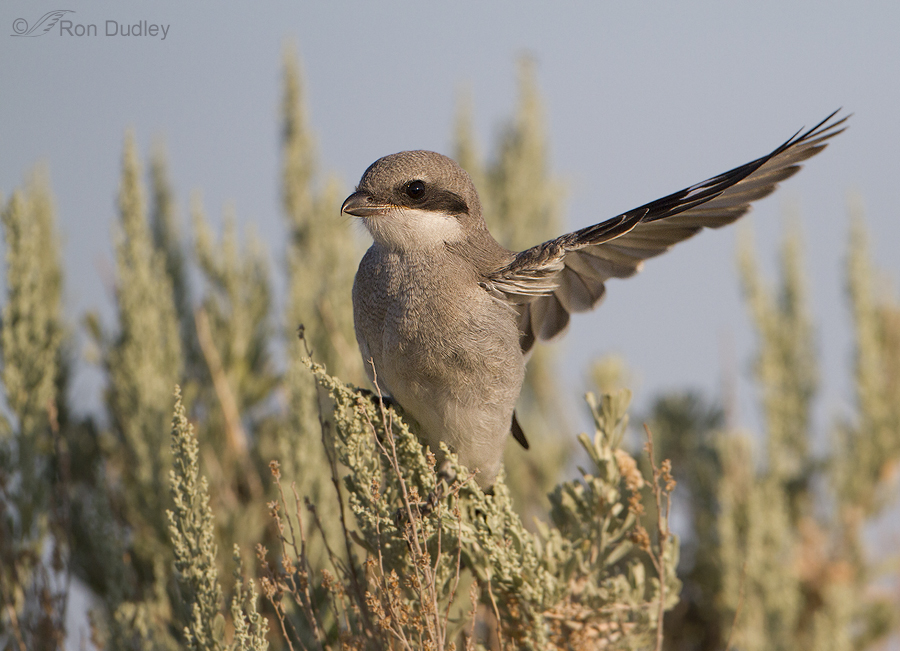
I photographed a family of very cooperative Loggerhead Shrikes last week on Antelope Island. The young birds had already fledged and were very actively exploring their world, strengthening their wing muscles by flying from perch to perch and testing a variety of objects for their potential food value.
And they were gutsy! Several times a juvenile landed on the tailgate of my pickup as you can see here.
A Shrike, A Deer Fly And A Feathered Photography Update
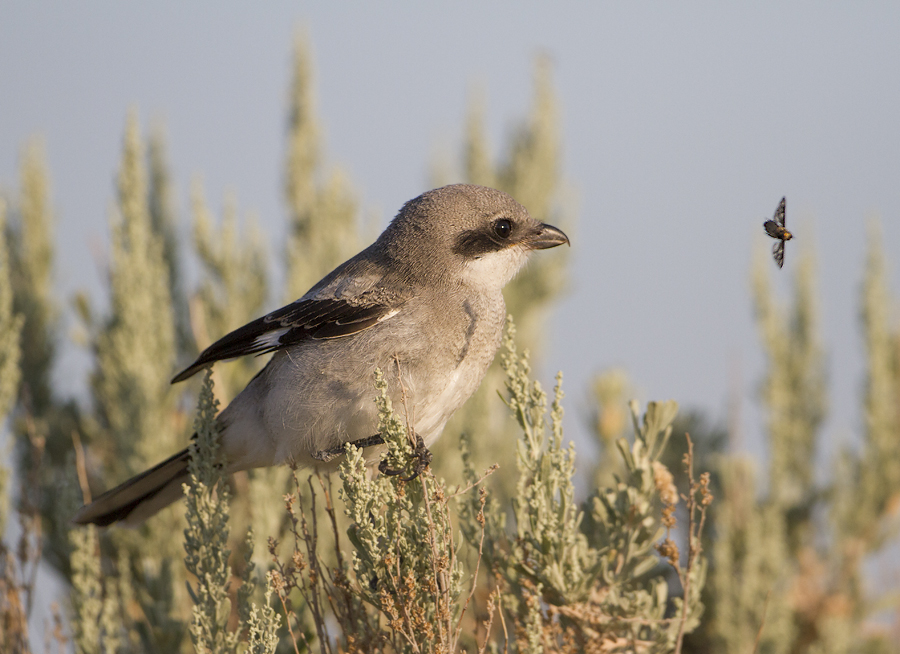
I thought this image was particularly interesting for several reasons.
This juvenile had been enthusiastically begging for food when a deer fly (I believe) unexpectedly appeared on the scene. A split second prior to this shot the bird had its wings out, its beak open and was squawking to be fed but the focus of its attention changed immediately when the biting insect appeared.
My Favorite Shrike Flight Shot
Loggerhead Shrike – The Bill Of A Killer
I’ve never been able to get a really good look at both the hook and tomial teeth on the bill of a Loggerhead Shrike in any of my images. Until two days ago on Antelope Island…
A Shrike Partially Consumes Its Own Pellet
This post is documentary only. The images are not aesthetically pleasing. Loggerhead Shrikes produce a pellet from an insect meal only 35.5 minutes (on average) after consumption. This is an amazingly fast turn-around time (Short-eared Owls average 8.5 hours before a pellet is produced from their rodent prey). When shrikes are consuming insects and spiders their pellets consist of the indigestible chitinous exoskeletons of those arthropods. I’ve seen and photographed Loggerhead Shrikes ejecting pellets many times but what I photographed on this August morning was new to me. Because of the cluttered setting I was mostly only watching this juvenile through my lens (not photographing it) when I could tell it was about to chuck up a pellet. Every time I’ve observed this behavior in the past the pellet was ejected quickly and cleanly and simply fell to the ground. But this bird had a surprise for me. It caught the pellet in the tip of its beak… and manipulated it there for some time. Then it very deliberately mashed up the pellet and appeared to be swallowing parts of it as other smaller pieces fell to the ground. My guess would be that about half of the pellet was consumed as the other half fell away, though I can’t be absolutely certain that any of it was actually eaten because my view of what was happening was not always a clear one. I wish I knew what was really going on here. This is the only time I’ve ever seen a bird (of any species) manipulate a pellet after…
Warm vs Cool Light – Minutes Matter
Color temperature (white balance) can make a big difference in photography and nature photography is certainly no exception. I seldom manipulate white balance during processing and never do it if I’m confident that my camera has rendered the image to look like it did in the field. 1/000, f/7.1, ISO 640, 500 f/4, 1.4 tc, natural light, not set up or called in The natural colors of the Loggerhead Shrike are gray, black and white but those colors are affected by the temperature of the light. I photographed this bird on November 26, 2012 at 7:56 am, very soon after the sun had come up over the Wasatch Mountains. Notice the warm, golden tones on the grays and the whites of the bird, and on the perch. They can even be seen in the almost black beak. 1/000, f/7.1, ISO 640, 500 f/4, 1.4 tc, natural light, not set up or called in Just 20 minutes later, at 8:16 am, I photographed this shrike on a different perch. By then the sun was higher in the sky and the light was filtered through relatively thin clouds. I think the difference in color tone of the two images is dramatic. Even though nature photographers often prefer warmer colors in their images I’m not suggesting that either warmer or cooler colors are necessarily “better” than the other. I’m only saying that they can have a huge overall effect on the image. And that mere minutes matter. Ron
Why The Killdeer Doesn’t “Perch”
More than half of all bird species (5000+) are classified in order Passeriformes and referred to as passerines. Passerines, sometimes known as perching birds or less accurately as songbirds, have four toes – three of them directed forward and one toe directed back. This arrangement allows for stable perching on structures such as small branches and herbaceous stems because the hind toe is opposable to the others (much like our thumbs are opposable to our fingers) which allows “grasping”. Interestingly, the tendon/bone anatomy of a passerine causes automatic closing of the foot (grasping) when the leg bends – such as when it lands on a typical perch. This arrangement also allows passerines to sleep on a perch without falling off. Here you can see the typical “three toe forward, one toe back” arrangement on this Savannah Sparrow that allows passerines to grasp narrow perches like branches or wires and remain stable on them. Animals without something like this toe arrangement would be “walking a tightrope” but these birds have no problem with it. Maintaining stability on a perch such as this would be virtually impossible without the ability to grasp, particularly in a breeze (this is a Loggerhead Shrike). This shot of a juvenile White-crowned Sparrow gives us a better look at all four toes. One more look at the opposable rear toe, this time on a Western Meadowlark. Ok, now to my point. Many birds that do not typically “perch” (with exceptions) are waterfowl and shorebirds. The Killdeer is a plover but because of the habitats…
Loggerhead Shrike Attempting To Impale A Grasshopper
Shrikes are well-known for impaling their prey on sharp projections like thorns or barbed wire as a means of food storage – they’re called “butcher birds” for good reason. I suspect the behavior to do so is innate but to become skilled at it takes practice. This past summer I found this Loggerhead Shrike on a fence on the Montana farm where I grew up. It had already captured the grasshopper when I arrived on the scene. First, my standard disclaimer for behavioral sequences. This bird was strongly sidelit so I seldom got a catch light and the light was harsh. To compensate, I did more processing with these images than I normally do because my intent is to show the behavior as well as possible, even though image quality suffered from the processing. Almost immediately I could see that the shrike was going to attempt to impale the grasshopper on the barb just below and in front of the beak of the bird. Impaling prey apparently isn’t an easy task. From all the contortions the bird went through… I’d assume that part of the problem was the awkward angle the shrike was at… to get proper leverage to complete the task. At one point the bird nearly fell off the fence. After a few moments the shrike gave up, turned its back on me with the grasshopper between its legs (and a gob of grasshopper on its bill) and seemed to contemplate what…
Shrikes And A Lesson For Me In Light
Birds on Antelope Island have been few and far between lately and yesterday was no exception. But a couple of Loggerhead Shrikes saved my morning and taught me yet another lesson in light. 1/1000, f/7.1, ISO 640, 500 f/4, 1.4 tc, natural light, not baited, set up or called in It was mostly cloudy on the island when we got there just as the sun was coming up over the mountains but there was a crack in those clouds that provided some very warm light for a few minutes just as we found this cooperative shrike. The golden light provides colors to the bird and perch – an effect that I like, especially with the dark storm clouds in the background. 1/500, f/7.1, ISO 640, 500 f/4, 1.4 tc, natural light, not baited, set up or called in I was only able to get off a few shots before the shrike flew to another perch, which gave me side light on the bird. This is a tricky lighting situation. When the bird was facing left into the sun the bright whites on the breast and neck “blew out” (too bright with no detail) and the shadows on the back of the shrike were too dark. But when it turned to its right and looked over its shoulder at me the exposure worked much better. The problem with this pose was getting both light in the eye and good eye contact. This image was one of the few that worked. I like the contrasting cool and warm tones on the shrike….
Loggerhead Shrike Take-offs
One of my current projects is take-off shots of Loggerhead Shrikes and I’m finding it to be unexpectedly difficult to get the quality I want. Take-offs of small birds are challenging by definition but I have quite a few that I like of other species so I’m a bit surprised that I’m struggling so with the shrikes. This past week I’ve had at least some success and these two are the best of the lot so far. 1/3200, f/6.3, ISO 500, 500 f/4, 1.4 tc On Tuesday morning this shrike gave me nice eye contact as it launched from its perch and I had good light and a clean background but I’m a bit surprised that the wings aren’t sharper. I doubt that it’s motion blur at 1/3200 and I was far enough away from the bird that I thought f/6.3 would give me more depth of field than this. Live and learn… 1/2500, f/7.1, ISO 500, 500 f/4, 1.4 tc Two mornings later I was photographing this shrike perched when an insect that interested it flew overhead. The bird has its eye on the bug as it’s taking off. This has been the best year on Antelope Island for Loggerhead Shrikes that I can remember as they seem to have had very good success so far in raising their broods. And with the plethora of huge orb-weaver spiders just coming on, things should only get better out there for shrikes. They love to eat those nasty looking spiders and feed them to their chicks. Which should mean more practice for me…
Fledgling Loggerhead Shrike Learning The Ropes
Yesterday we came across this Loggerhead Shrike fledgling perched high and pretty in the early morning light. 1/500, f/8, ISO 640, 500 f/4, 1.4 tc A few minutes after this shot was taken the bird flew off so we decided to look for more opportunities elsewhere and left the area. 1/2000, f/6.3, ISO 500, 500 f/4, 1.4 tc Just before we quit shooting for the day we decided to look for the fledgling again in the same area as before. We found two of them this time – one flew off almost immediately but this one allowed us some close observations for about 25 minutes. By this time of the morning the bird was side-lit in most situations but we got to see some interesting behaviors. Typical of youngsters this one was curious about its surroundings and spent quite a bit of time exploring the greasewood bush it was in. Here it is about to half hop/half fly to the twigs in the upper left of the frame. 1/2500, f/6.3, ISO 500, 500 f/4, 1.4 tc Several times it picked off one of the drier greasewood buds and played with it for a while. 1/2500, f/6.3, ISO 500, 500 f/4, 1.4 tc But a parent coming in with food always got the full attention of the fledgling. In this image one of the adults is delivering a grasshopper to the begging young bird – you can just see the top of the parents head at the bottom of the frame as it works its way…
Birds “Wearing To Dark” – Some Visual Evidence As To Why

This past summer I posted these first two Loggerhead Shrike images as evidence that the ventral colors of the species change from white to almost black as the summer wears on and asked my readers why this occurs. Several responded with a logical explanation.
Three days ago I photographed a Horned Lark that may demonstrate that those readers were right.
Loggerhead Shrikes – A Color Change I Don’t Understand
I’m confused about a color change I’m seeing in Loggerhead Shrikes. 1600, f/7.1, ISO 640, 500 f/4, 1.4 tc, natural light, image taken 4/26/13 on Antelope Island For most of the year the adults I see have a white or pale ventral surface (belly, breast and sides) which is exactly as described in the field guides and other resources I have access to. 2500, f/6.3, ISO 640, 500 f/4, natural light, image taken 7/3/13 on Antelope Island But beginning in about early July there’s a fairly dramatic change that is not addressed in my field guides. That white plumage turns significantly darker and an almost black area on the upper breast appears. This is about the time they’re fledging chicks around here and when I first noticed this several years ago I wondered if the birds were simply becoming “dirty” as they scurried around trying to feed and care for those very demanding youngsters. But now I’m pretty sure that’s not the case. All of the adult Loggerhead Shrikes I see go through this change to some degree or another. 3200, f/5.6, ISO 640, 500 f/4, 1.4 tc, natural light, image taken 7/14/13 on Antelope Island Here’s another (pretty silly looking) example. This is also the time of year when these birds are molting so I wondered if I was somehow seeing black skin (some birds do have black skin) through very skimpy plumage that time of year and I was somehow mistaking it for black feathers. But as you can see in this preening, molting adult, their skin…
Enveloped By Shrikes!
Fledgling Loggerhead Shrike Begging For Food

I photographed a family of very cooperative Loggerhead Shrikes last week on Antelope Island. The young birds had already fledged and were very actively exploring their world, strengthening their wing muscles by flying from perch to perch and testing a variety of objects for their potential food value.
And they were gutsy! Several times a juvenile landed on the tailgate of my pickup as you can see here.
A Shrike, A Deer Fly And A Feathered Photography Update

I thought this image was particularly interesting for several reasons.
This juvenile had been enthusiastically begging for food when a deer fly (I believe) unexpectedly appeared on the scene. A split second prior to this shot the bird had its wings out, its beak open and was squawking to be fed but the focus of its attention changed immediately when the biting insect appeared.
My Favorite Shrike Flight Shot
Loggerhead Shrike – The Bill Of A Killer
I’ve never been able to get a really good look at both the hook and tomial teeth on the bill of a Loggerhead Shrike in any of my images. Until two days ago on Antelope Island…
A Shrike Partially Consumes Its Own Pellet
This post is documentary only. The images are not aesthetically pleasing. Loggerhead Shrikes produce a pellet from an insect meal only 35.5 minutes (on average) after consumption. This is an amazingly fast turn-around time (Short-eared Owls average 8.5 hours before a pellet is produced from their rodent prey). When shrikes are consuming insects and spiders their pellets consist of the indigestible chitinous exoskeletons of those arthropods. I’ve seen and photographed Loggerhead Shrikes ejecting pellets many times but what I photographed on this August morning was new to me. Because of the cluttered setting I was mostly only watching this juvenile through my lens (not photographing it) when I could tell it was about to chuck up a pellet. Every time I’ve observed this behavior in the past the pellet was ejected quickly and cleanly and simply fell to the ground. But this bird had a surprise for me. It caught the pellet in the tip of its beak… and manipulated it there for some time. Then it very deliberately mashed up the pellet and appeared to be swallowing parts of it as other smaller pieces fell to the ground. My guess would be that about half of the pellet was consumed as the other half fell away, though I can’t be absolutely certain that any of it was actually eaten because my view of what was happening was not always a clear one. I wish I knew what was really going on here. This is the only time I’ve ever seen a bird (of any species) manipulate a pellet after…
Warm vs Cool Light – Minutes Matter
Color temperature (white balance) can make a big difference in photography and nature photography is certainly no exception. I seldom manipulate white balance during processing and never do it if I’m confident that my camera has rendered the image to look like it did in the field. 1/000, f/7.1, ISO 640, 500 f/4, 1.4 tc, natural light, not set up or called in The natural colors of the Loggerhead Shrike are gray, black and white but those colors are affected by the temperature of the light. I photographed this bird on November 26, 2012 at 7:56 am, very soon after the sun had come up over the Wasatch Mountains. Notice the warm, golden tones on the grays and the whites of the bird, and on the perch. They can even be seen in the almost black beak. 1/000, f/7.1, ISO 640, 500 f/4, 1.4 tc, natural light, not set up or called in Just 20 minutes later, at 8:16 am, I photographed this shrike on a different perch. By then the sun was higher in the sky and the light was filtered through relatively thin clouds. I think the difference in color tone of the two images is dramatic. Even though nature photographers often prefer warmer colors in their images I’m not suggesting that either warmer or cooler colors are necessarily “better” than the other. I’m only saying that they can have a huge overall effect on the image. And that mere minutes matter. Ron
Why The Killdeer Doesn’t “Perch”
More than half of all bird species (5000+) are classified in order Passeriformes and referred to as passerines. Passerines, sometimes known as perching birds or less accurately as songbirds, have four toes – three of them directed forward and one toe directed back. This arrangement allows for stable perching on structures such as small branches and herbaceous stems because the hind toe is opposable to the others (much like our thumbs are opposable to our fingers) which allows “grasping”. Interestingly, the tendon/bone anatomy of a passerine causes automatic closing of the foot (grasping) when the leg bends – such as when it lands on a typical perch. This arrangement also allows passerines to sleep on a perch without falling off. Here you can see the typical “three toe forward, one toe back” arrangement on this Savannah Sparrow that allows passerines to grasp narrow perches like branches or wires and remain stable on them. Animals without something like this toe arrangement would be “walking a tightrope” but these birds have no problem with it. Maintaining stability on a perch such as this would be virtually impossible without the ability to grasp, particularly in a breeze (this is a Loggerhead Shrike). This shot of a juvenile White-crowned Sparrow gives us a better look at all four toes. One more look at the opposable rear toe, this time on a Western Meadowlark. Ok, now to my point. Many birds that do not typically “perch” (with exceptions) are waterfowl and shorebirds. The Killdeer is a plover but because of the habitats…
Loggerhead Shrike Attempting To Impale A Grasshopper
Shrikes are well-known for impaling their prey on sharp projections like thorns or barbed wire as a means of food storage – they’re called “butcher birds” for good reason. I suspect the behavior to do so is innate but to become skilled at it takes practice. This past summer I found this Loggerhead Shrike on a fence on the Montana farm where I grew up. It had already captured the grasshopper when I arrived on the scene. First, my standard disclaimer for behavioral sequences. This bird was strongly sidelit so I seldom got a catch light and the light was harsh. To compensate, I did more processing with these images than I normally do because my intent is to show the behavior as well as possible, even though image quality suffered from the processing. Almost immediately I could see that the shrike was going to attempt to impale the grasshopper on the barb just below and in front of the beak of the bird. Impaling prey apparently isn’t an easy task. From all the contortions the bird went through… I’d assume that part of the problem was the awkward angle the shrike was at… to get proper leverage to complete the task. At one point the bird nearly fell off the fence. After a few moments the shrike gave up, turned its back on me with the grasshopper between its legs (and a gob of grasshopper on its bill) and seemed to contemplate what…
Shrikes And A Lesson For Me In Light
Birds on Antelope Island have been few and far between lately and yesterday was no exception. But a couple of Loggerhead Shrikes saved my morning and taught me yet another lesson in light. 1/1000, f/7.1, ISO 640, 500 f/4, 1.4 tc, natural light, not baited, set up or called in It was mostly cloudy on the island when we got there just as the sun was coming up over the mountains but there was a crack in those clouds that provided some very warm light for a few minutes just as we found this cooperative shrike. The golden light provides colors to the bird and perch – an effect that I like, especially with the dark storm clouds in the background. 1/500, f/7.1, ISO 640, 500 f/4, 1.4 tc, natural light, not baited, set up or called in I was only able to get off a few shots before the shrike flew to another perch, which gave me side light on the bird. This is a tricky lighting situation. When the bird was facing left into the sun the bright whites on the breast and neck “blew out” (too bright with no detail) and the shadows on the back of the shrike were too dark. But when it turned to its right and looked over its shoulder at me the exposure worked much better. The problem with this pose was getting both light in the eye and good eye contact. This image was one of the few that worked. I like the contrasting cool and warm tones on the shrike….
Loggerhead Shrike Take-offs
One of my current projects is take-off shots of Loggerhead Shrikes and I’m finding it to be unexpectedly difficult to get the quality I want. Take-offs of small birds are challenging by definition but I have quite a few that I like of other species so I’m a bit surprised that I’m struggling so with the shrikes. This past week I’ve had at least some success and these two are the best of the lot so far. 1/3200, f/6.3, ISO 500, 500 f/4, 1.4 tc On Tuesday morning this shrike gave me nice eye contact as it launched from its perch and I had good light and a clean background but I’m a bit surprised that the wings aren’t sharper. I doubt that it’s motion blur at 1/3200 and I was far enough away from the bird that I thought f/6.3 would give me more depth of field than this. Live and learn… 1/2500, f/7.1, ISO 500, 500 f/4, 1.4 tc Two mornings later I was photographing this shrike perched when an insect that interested it flew overhead. The bird has its eye on the bug as it’s taking off. This has been the best year on Antelope Island for Loggerhead Shrikes that I can remember as they seem to have had very good success so far in raising their broods. And with the plethora of huge orb-weaver spiders just coming on, things should only get better out there for shrikes. They love to eat those nasty looking spiders and feed them to their chicks. Which should mean more practice for me…
Fledgling Loggerhead Shrike Learning The Ropes
Yesterday we came across this Loggerhead Shrike fledgling perched high and pretty in the early morning light. 1/500, f/8, ISO 640, 500 f/4, 1.4 tc A few minutes after this shot was taken the bird flew off so we decided to look for more opportunities elsewhere and left the area. 1/2000, f/6.3, ISO 500, 500 f/4, 1.4 tc Just before we quit shooting for the day we decided to look for the fledgling again in the same area as before. We found two of them this time – one flew off almost immediately but this one allowed us some close observations for about 25 minutes. By this time of the morning the bird was side-lit in most situations but we got to see some interesting behaviors. Typical of youngsters this one was curious about its surroundings and spent quite a bit of time exploring the greasewood bush it was in. Here it is about to half hop/half fly to the twigs in the upper left of the frame. 1/2500, f/6.3, ISO 500, 500 f/4, 1.4 tc Several times it picked off one of the drier greasewood buds and played with it for a while. 1/2500, f/6.3, ISO 500, 500 f/4, 1.4 tc But a parent coming in with food always got the full attention of the fledgling. In this image one of the adults is delivering a grasshopper to the begging young bird – you can just see the top of the parents head at the bottom of the frame as it works its way…


